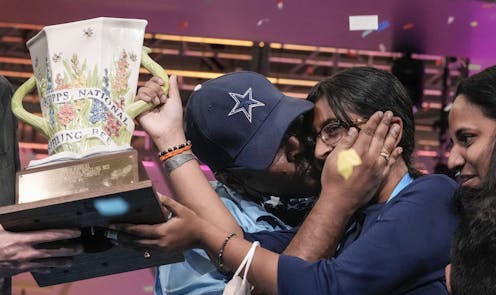How Indian American spelling bee dominance may fuel educational inequities
- Written by Pawan Dhingra, Professor of Sociology and American Studies; Faculty Equity and Inclusion Officer, Amherst College

Harini Logan[1], a cheerful 14-year-old from San Antonio, Texas, made history on June 2, 2022. She became the first Scripps National Spelling Bee champion to win after being eliminated and later reinstated. She was also the first to prevail in a lightning-round tiebreaker[2] with the runner-up.
But the fact that she is Indian American – a group that makes up about 1.3% of the U.S. population[3] – is hardly unusual. Over the past 20 years, Indian Americans have come to dominate[4] the Scripps National Spelling Bee – with 21 of the past 23 champions being of South Asian descent.
One of the two exceptions was Zaila Avant-garde[5], also 14. When she won the bee in 2021, she became the Scripps contest’s first Black champion from the U.S.
The bee was canceled in 2020, but there were eight co-champions[6] in 2019, seven of whom were Indian American.
There’s even a documentary on this endearing story, “Spelling the Dream[7].” But I contend that the commitment of Indian Americans to these competitions stems partly from perceived hurdles they face in higher education. And I believe that their achievements inadvertently further educational inequalities.
The academic track
I spent years with Indian American, white and other families engaged in spelling bees, math competitions and other after-school academics while doing research for my book “Hyper Education: Why Good Schools, Good Grades, and Good Behavior Are Not Enough[8].”
In one chapter, I explained why Indian Americans have come to dominate bees. I believe that their success has to do with a firm commitment by families to spend the time and money necessary to help their kids fully prepare. These children excel not just in spelling bees but also in geography, math and other academic competitions.
Most of my book addresses a more revealing question: why families care about such competitions and advanced academics in the first place and the implications around that.
Most U.S. kids participate in activities outside school[9], usually involving sports, the arts, religious or civic activities. Indian immigrant children do these things too, but many of their parents also make them at least try extracurricular academic activities, especially competitive ones.
The more than 100 Indian American parents I interviewed between 2011 and 2018 believed that to have a good shot at getting into a prominent university, their children would need an undeniably strong academic record to compensate for what they saw as weak networks and a lack of college legacy status[10].
Parents also worried that college admission officers might hold their children, as Asian Americans, to a higher standard[11] in expected test scores.
“We have to have 130 points above other groups,” one father of a spelling contestant said about the SAT college entrance exam. He assured me that tutoring centers and spelling bees would help his daughter get a higher score, an attitude echoed by other parents and children alike.
Pursuing after-school education to help their children eventually become more competitive college applicants makes sense to these immigrant parents, given their own upbringing with similar tutoring. I think it’s only natural for parents to promote what they are most familiar with, and many of these parents have advanced degrees[12] and grew up with intense academic expectations.
In ‘Spelling the Dream,’ a documentary, viewers see how hard Indian American families work to prepare their children to win bees.A cost of achievement
As Indian American children boost their test scores and other academics through studying words, mastering quadratic equations and other intellectual endeavors, they inadvertently contribute to what I see as a troubling trend: the widening educational gaps[13] between higher-income and lower-income families.
Achieving in these competitions often requires spending hundreds or even thousands of dollars. Hexco, a publisher specializing in contest preparation, sells word guides and packages of eight coaching sessions that cost US$1,725.
According to its website, 94% of spellers who “advanced to the Scripps finals … were Hexco customers”[14] in 2019.
Indian Americans have a median household income of $119,000[15], well above the national median of $85,800. Many of them use this economic edge to advance their children’s grades and scores.
So, while Indian Americans gravitate toward academic competitions because they worry that otherwise their children will lack equal opportunities, they reinforce educational inequality in the process.
This is related to the growing trend of supplemental education[16] by higher-income families generally, which I also studied.
The pursuit of after-school education, whether through competitions or tutoring centers, is increasingly common for middle-class families. I’m certain that it’s prone to grow even more. Online tutoring alone is expected to grow to an almost $3 billion industry[17] worldwide by 2025.
And while the reasons parents pay for and encourage this practice can have something to do with their ethnic backgrounds, one outcome is the same: growing educational inequality.
This is an updated version of an article first published on July 20, 2020[18].
References
- ^ Harini Logan (apnews.com)
- ^ lightning-round tiebreaker (www.theguardian.com)
- ^ 1.3% of the U.S. population (www.pewsocialtrends.org)
- ^ Indian Americans have come to dominate (theconversation.com)
- ^ Zaila Avant-garde (theconversation.com)
- ^ eight co-champions (www.nytimes.com)
- ^ Spelling the Dream (www.netflix.com)
- ^ Hyper Education: Why Good Schools, Good Grades, and Good Behavior Are Not Enough (nyupress.org)
- ^ kids participate in activities outside school (www.pewsocialtrends.org)
- ^ college legacy status (www.ivywise.com)
- ^ a higher standard (www.jstor.org)
- ^ have advanced degrees (www.pewsocialtrends.org)
- ^ widening educational gaps (hechingerreport.org)
- ^ were Hexco customers” (www.hexco.com)
- ^ median household income of $119,000 (www.pewresearch.org)
- ^ trend of supplemental education (theconversation.com)
- ^ almost $3 billion industry (finance.yahoo.com)
- ^ July 20, 2020 (theconversation.com)
Authors: Pawan Dhingra, Professor of Sociology and American Studies; Faculty Equity and Inclusion Officer, Amherst College


